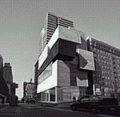Sunday, June 08, 2003
Journalists have got to stop
these witless disproportionate witch-hunts!
--Joe Klein, ABC ThisWeek

Trial of Geo Jacobs, 1692
Yes, yes, I grimly sat through portions of whatever it is Disney calls the program that, mercifully now, no longer includes Sam or Cokie. Aside from Mr. Will’s innate petulance, Klein’s remark is the only ABC program remnant to linger.
Having other things to do, I failed to catch the National Security Advisor’s appearance on Meet the Press but did manage to watch her high wire unicycle act before the sad basset hound eyes of 41’s old friend Bob Schieffer. While almost dazzled by Condi’s brilliantly white outfit I retained enough of my faculties to be reminded of her “non traditional hijacking” post 911 press conference. Then as now Condi’s eyes seem to have a life and outlook separate from the rest of her body and the evolving logic of her speech. Earlier this week I hopefully cast an amused allegorical eye at Dr Rice as a Cleopatra. This afternoon I am leaning more toward late play Lady MacBeth.
Many have written about a lack of connection between the thrust of some newspaper headlines and the content of the stories they claim to represent. Very early this morning I noticed a headline, In Game of Low Expectations, Bush Usually Wins. I, then, read the Washington Post A Section story. Next, I went to a story about the Iraq National Museum that held more personal interest. Going back now to write about the curious Museum article I noticed the headline had changed on the Bush story. It now reads, In Game of Expectations, Bush Usually Wins, and I would ask any Washington Post Copy Desk Editor to please explain the modified headline’s meaning much less if it relates to the companion story.

The Post story about the Iraq National Museum is, as I said, curious. To my mind it is the first reference to the looting in the media since a press conference from the Baghdad Museum was televised on May 16th.
In the days following the initial breathless looting reports, and if we are discovering anything it is that the Iraqi do everything breathlessly, we have learned that the bulk of missing material while historically valuable really held very little economic value.
We learned that 37 of the most valuable were still missing.
Except for the 4,500-year-old Golden Harp of Ur found broken on the Museum floor, we learned that these missing 37 items were the ones taken promptly by Westerners using western tools.
We learned, from Iraqi shortly after the statue’s fall, that the bulk of the gold objects from the Iraq Museum, usually referred to as the Treasures of Nimrud, were sealed in flooded vaults under the bombed Iraq Central Bank.
And, we learned that the Museum’s records were meager, mostly paper, almost totally destroyed and that they, and the missing objects, were “salvageable” but beyond complete recovery.
This morning, under a headline that could have been written a month ago, Most Iraq Treasures Recovered, I read a story filled more with justification than fact and a Bushian insistence on “numbers”:
Reports describing the looting of Iraq's archaeological treasures from the national museum were exaggerated, and most of the precious inscribed tablets, gold jewelry and artwork dating from the birth of civilization have been recovered, a team of U.S. investigators said today…U.S. officials…now say 3,000 pieces remain unaccounted for and may have disappeared into the shadowy world of black market antiquities trading…More importantly, of the 8,000 items considered the most precious by archaeologists, only 47 are still missing…The investigation was led by U.S. Customs Service agents and State Department officials. Iraqi archaeologists and museum administrators could not be reached for comment on the report or to verify the number of recovered and missing items cited by the Americans.
Suddenly, deep in the story, I spot part of what could have been the lead paragraph:
At the Iraqi Central Bank, the investigators and their Iraqi counterparts spent almost two weeks pumping water out of the basement to reveal the inundated vault of Mesopotamian antiquities. Inside, the team found 179 boxes containing most of the exhibit-quality collection of the national museum, including the Treasures of Nimrud, an ancient Assyrian city near present-day Mosul in northern Iraq.
From my read of older news reports the gold objects under the Central Bank were never considered missing just not easily recoverable and possibly damaged.

This week, the New York Times raves about the new Contemporary Art Center in downtown Cincinnati:
Architectural and urban history were made here recently with the opening of Zaha Hadid's first American building…a work of international stature that confidently meets the high expectations aroused by this prodigiously gifted architect…the Rosenthal Center is the most important American building to be completed since the end of the cold war.
Herbert Muschamp does a terrific job explaining Hadid’s concept and fitting its realization into an artistic and urban context. Best of all, the headline, Zaha Hadid’s Urban Mothership, actually describes the story. Go figure!
Painting: TH Matteson,1855


